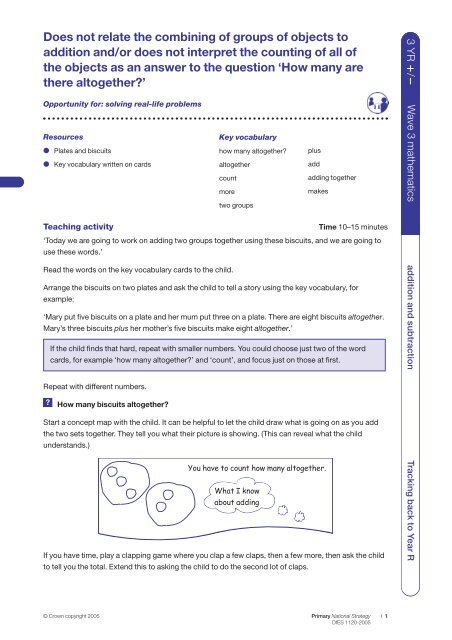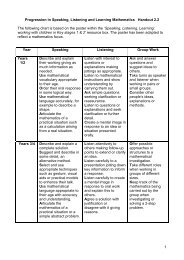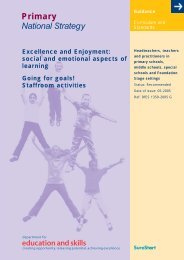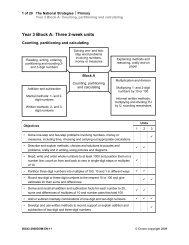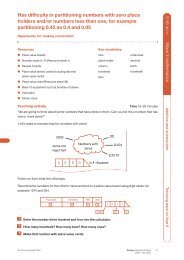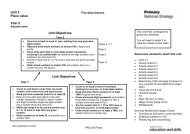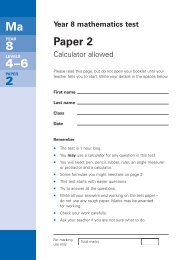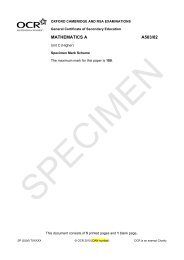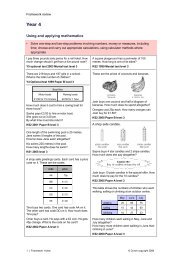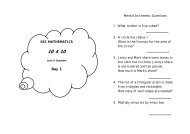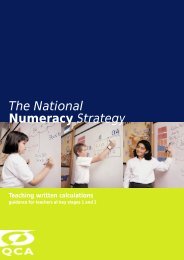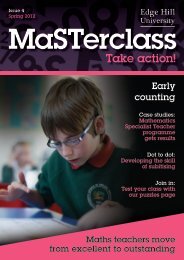3YR 5P
3YR 5P
3YR 5P
- No tags were found...
You also want an ePaper? Increase the reach of your titles
YUMPU automatically turns print PDFs into web optimized ePapers that Google loves.
Does not relate the combining of groups of objects toaddition and/or does not interpret the counting of all ofthe objects as an answer to the question ‘How many arethere altogether?’Opportunity for: solving real-life problemsResources● Plates and biscuits● Key vocabulary written on cardsTeaching activityTime 10–15 minutes‘Today we are going to work on adding two groups together using these biscuits, and we are going touse these words.’Read the words on the key vocabulary cards to the child.Arrange the biscuits on two plates and ask the child to tell a story using the key vocabulary, forexample:‘Mary put five biscuits on a plate and her mum put three on a plate. There are eight biscuits altogether.Mary’s three biscuits plus her mother’s five biscuits make eight altogether.’Repeat with different numbers.?How many biscuits altogether?Key vocabularyhow many altogether?altogethercountIf the child finds that hard, repeat with smaller numbers. You could choose just two of the wordcards, for example ‘how many altogether?’ and ‘count’, and focus just on those at first.Start a concept map with the child. It can be helpful to let the child draw what is going on as you addthe two sets together. They tell you what their picture is showing. (This can reveal what the childunderstands.)You have to count how many altogether.What I knowabout addingIf you have time, play a clapping game where you clap a few claps, then a few more, then ask the childto tell you the total. Extend this to asking the child to do the second lot of claps.moretwo groupsplusaddadding togethermakes3 YR /Wave 3 mathematics addition and subtraction Tracking back to Year R© Crown copyright 2005 Primary National Strategy I 1DfES 1120-2005
3 YR /Spotlight 1Does not relate the combining of groups of objects to addition and/or does not interpret the countingof all of the objects as an answer to the question ‘How many are there altogether?’Opportunity for: communicating mathematical ideasHow many now?Time 10–15 minutesResources● Beads● Two pieces of card or paper● Number cards (Resource sheets 1 and 2)Teaching activityKey vocabularyhow many altogether?altogethercountmoretwo groupsplusaddadding togethermakes‘Today we are going to do some adding with these beads.’?Count seven beads. Are you sure you are right?Use this opportunity to check the child’s counting skills.Now split the beads into two groups, or let the child do that, for example three and four beads, thencover each group with a piece of paper.?How many beads are there altogether?If the child cannot work out there are still seven, let them look under one piece of paper at a time, firstthe three, then the four.?How can you work out how many altogether?Watch carefully what the child does. Clarify that to answer the question ‘How many altogether?’ theyhave to add both of the groups.If the child still finds this difficult, show the two groups and let the child talk about what they cansee, using the key vocabulary words. Then combine the two groups.Record some of the sentences the child can make on the concept map.You have to count how many altogether.What I knowabout adding.3 and 4 makes 7.You add two groups together.If you have time, do some clapping again.2 I Primary National Strategy © Crown copyright 2005DfES 1120-2005
Spotlight 2Does not relate the combining of groups of objects to addition and/or does not interpret the countingof all of the objects as an answer to the question ‘How many are there altogether?’Opportunity for: exploring mathematical ideas3 YR /Pennies in pursesTime 5–15 minutesResources● Some 1p coins● Two purses● Vocabulary words on cards● Number line or number trackKey vocabularyhow many altogether?altogethercountmoretwo groupsplusaddadding togethermakestallycount onTeaching activityPut an amount of money in each purse and ask the child to count the coins. Then, keeping the twoamounts separate, ask the child to count how much money there is altogether.Put all the money into one purse and ask the child:?How much money is there altogether?If the child is unsure, empty the purse and count the money.You could record a number sentence using the vocabulary words.5 pennies and 4 more pennies makes 9 pennies altogether.If the child does not seem to understand the process of adding the two groups, you might wantthe child to make a tally for each set of coins to reinforce the counting.?How many tally marks altogether?If the child counts from one each time, you might need to do more work on counting(see 1 YR +/–).Repeat with different amounts of money.?What could we add to our concept map today?© Crown copyright 2005 Primary National Strategy I 3DfES 1120-2005
3 YR /Spotlight 3Does not relate the combining of groups of objects to addition and/or does not interpret the countingof all of the objects as an answer to the question ‘How many are there altogether?’Opportunity for: reasoning about numbersCalculator addingTime 10–15 minutesResources● Calculator● Number cards and symbol cards(Resource sheets 1, 2 and 8)● Counters or cubes● Vocabulary on cardTeaching activityKey vocabularyhow many altogether?altogethercountmoretwo groupsplusaddadding togethermakescount on‘Today we are going to use a calculator to do some adding.’‘Show me if you can put a number sentence into the calculator.’Watch the child very carefully to see what they do, especially whether they can identify the+and=keys.If the child seems unfamiliar with a calculator, you will need to give them a while to play with it andexplore what the keys do. They need to know about the cancel key and to be able to see that theycan key in numbers, revealing them on the display.?Can you read what it says on the display now?Using the key vocabulary words, help the child to construct a number sentence with cards, with cubesand with words.2 + 5 = 72 plus 5 more makes 7 altogether.If you add 2 and 5 together that makes 7.2 add 5 makes 7.2 more than 5 is 7.To add 2 and 5 you count how many altogether.If the child is not yet using the vocabulary words fluently, you will need to repeat their use over thenext few weeks. You could do that in short three-minute sessions with a calculator at registrationtime, asking the child to key in an addition number sentence each day and recording it with cubesor with cards. Emphasise that the two groups of cubes need to be pushed together and thencounted so that you can find out how many altogether.4 I Primary National Strategy © Crown copyright 2005DfES 1120-2005
? What did you learn today?Give all children time to explore what a calculator can do. They need to be able to use all four operationkeys and be familiar with what those keys do.Challenge some to create addition calculations with huge numbers, for example they might key in23 456 + 34 567.3 YR /?The answer to one of my addition calculations is 98 765. What could my numbers have beento give that answer? (If you don’t say which two numbers, some children might make the answerwith three or more numbers, for example you could make it with1 + 1 + 1 +…, keying in198 765 times!)Spotlight 4Does not relate the combining of groups of objects to addition and/or does not interpret the countingof all of the objects as an answer to the question ‘How many are there altogether?’Opportunity for: developing mental imagesAdding storiesTime 10 minutesResources● Cubes or other small items● Hoops or bits of paper● DiceKey vocabularyhow many altogether?countmoretwo groupsplusaddadding togethermakesTeaching activity‘Today we are going to create some stories which include adding.’You could choose a context to suit the child. For example, you could use a sports context: three goalsscored in the first half and another four scored in the second half.‘There are three puppies in the basket and two want to climb in.’?How many altogether? Show me how you know that.If the child needs more practice, you could use two hoops or bits ofpaper to show the two groups, then combine the groups.?What could you do to find out how many altogether?‘Four biscuits and four more biscuits makes eight altogether.’If the child needs more help, you might want to let them throw a dice twice and count out the rightnumber of cubes. You could record the number sentences with them, for example 6 + 3 = 9.© Crown copyright 2005 Primary National Strategy I 5DfES 1120-2005
3 YR /? If I have three buns on one plate and eight on the other, what could I do to find out how manyI have altogether?‘Let’s make a list of all the words we can think of that we use when we say an addition numbersentence.’‘Some kittens are black and some are tabby. Altogether there are eleven kittens.’?How many black kittens and how many tabby kittens could there be?Spotlight 5: a learning checkDoes not relate the combining of groups of objects to addition and/or does not interpret the countingof all of the objects as an answer to the question ‘How many are there altogether?’Opportunity for: explaining and discussingTiddlywinksResourcesTime 5–15 minutesCheck: does the child use key vocabulary?● Two children● Tiddlywinks game● Two targets● One-minute timer● Vocabulary cards● Number cards and symbol cards(Resource sheets 1 and 2)how many altogether?countmoretwo groupsplusaddadding togethermakescount onTeaching activity‘This game, Tiddlywinks, will help you with your adding.’How to play1. Each player has a target.2. Set the timer to ring after one minute.3. Each player tries to get as many of their counters onto the target as they can in one minute.4. After one minute, the players combine their groups of counters and find out how many altogether.5. They work together to make an addition number sentence with the cards, for example 8 + 4 = 12.Variations● Play the game on the floor using two hoops and beanbags.● Play the game by tossing a dice to get the two numbers.6 I Primary National Strategy © Crown copyright 2005DfES 1120-2005
Learning outcomesBy the end of this set of activities, children should be able to:● tackle related learning tasks with increased motivation and confidence;● use and understand connected mathematical vocabulary;● know that to add two numbers you combine the two groups and count all the objects;● use a calculator to key in an addition number sentence, recognising the+and=keys.3 YR /Altogether makesTime 10–15 minutesDoes not relate the combining of groups of objects to addition and/or does not interpret the countingof all the objects as an answer to the question ‘How many are there altogether?’Resources● Blank loop track (Resource sheet 20)● Dice, number cards or spinners(Resource sheet 12)● CubesCheck: does the child use key vocabulary?addadd both numbersplusmakeshow many altogether? equals● Counters● Stopwatch● Rewards● At least two childrenTeaching activity‘Today we are going to play a game, Altogether makes, to help you to be able to add two numbersreally well.’Prepare the blank loop track (Resource sheet 20) perhaps with some stickers or some decorationrelated to the child’s interests or a class theme.Select dice, spinners or cards to practise with numbers appropriate for the child, for example twocopies of the hexagon spinner from Resource sheet 12 could be filled with numbers from 1 to 6.Children can cooperate in pairs to play, or they can compete.How to play1. Each player or pair puts their counter on the starting position. Timing can be started using thestopwatch if appropriate.2. Players take turns to spin two numbers and add them together. The player makes the two numbersthey have spun from cubes, counts the total, then moves their counter the number of spacesrepresented by the total.3. Then the other player or pair spins two numbers and moves their counter.4. Every time a player passes the start they win a reward or score three points. Scores can berecorded as tally marks.© Crown copyright 2005 Primary National Strategy I 7DfES 1120-2005
3 YR /5. Keep going round until it is time to stop. Look at the stopwatch to find out how long the game took.Next time the children should try to go faster, winning more points in the time.Variations● Play with another spinner or dice so that three numbers are added together.● Play without winning points but race to be first to get round the track three times.● Play with just numbers 1, 2, 3 and 4 using the round spinner.● If children need help with recognising the + and = signs, they could use a calculator to enter theirnumbers.8 I Primary National Strategy © Crown copyright 2005DfES 1120-2005


